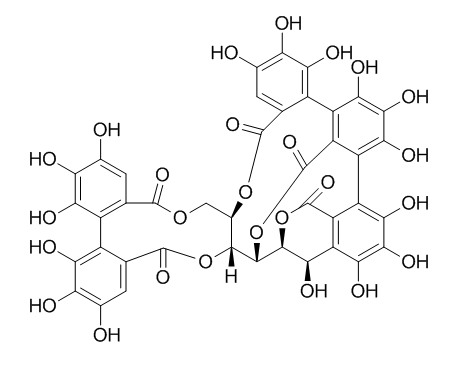Vescalagin
Vescalagin acts as a preferential catalytic inhibitor of the α isoform of human DNA topoisomerase II. Vescalagin has hypotriglyceridemic and hypoglycemic efects, it could have therapeutic value against diabetic progression.
Inquire / Order:
manager@chemfaces.com
Technical Inquiries:
service@chemfaces.com
Tel:
+86-27-84237783
Fax:
+86-27-84254680
Address:
1 Building, No. 83, CheCheng Rd., Wuhan Economic and Technological Development Zone, Wuhan, Hubei 430056, PRC
Providing storage is as stated on the product vial and the vial is kept tightly sealed, the product can be stored for up to
24 months(2-8C).
Wherever possible, you should prepare and use solutions on the same day. However, if you need to make up stock solutions in advance, we recommend that you store the solution as aliquots in tightly sealed vials at -20C. Generally, these will be useable for up to two weeks. Before use, and prior to opening the vial we recommend that you allow your product to equilibrate to room temperature for at least 1 hour.
Need more advice on solubility, usage and handling? Please email to: service@chemfaces.com
The packaging of the product may have turned upside down during transportation, resulting in the natural compounds adhering to the neck or cap of the vial. take the vial out of its packaging and gently shake to let the compounds fall to the bottom of the vial. for liquid products, centrifuge at 200-500 RPM to gather the liquid at the bottom of the vial. try to avoid loss or contamination during handling.
Hum Exp Toxicol.2022, 41:9603271221143713.
Phytomedicine.2019, 65:153089
Biomed Pharmacother.2020, 125:109784.
Asian J Beauty Cosmetol2024, 22(1): 103-112.
Cell Physiol Biochem.2017, 44(4):1381-1395
Neurotox Res.2022, 40(6):1937-1947.
Front Plant Sci.2017, 8:723
Int J Food Sci Nutr.2019, 70(7):825-833
Pharmaceutics.2022, 14(3):564.
J Plant Biochem.Biotech.2024, 33:353-366.
Related and Featured Products
Molecular Pharmacology, 2012, 82(1):134-141.
The polyphenolic ellagitannin vescalagin acts as a preferential catalytic inhibitor of the α isoform of human DNA topoisomerase II.[Reference:
WebLink]
Polyphenolic ellagitannins are natural compounds that are often associated with the therapeutic activity of plant extracts used in traditional medicine. They display cancer-preventing activity in animal models by a mechanism that remains unclear. Potential targets have been proposed, including DNA topoisomerases II (Top2). Top2α and Top2β, the two isoforms of the human Top2, play a crucial role in the regulation of replication, transcription, and chromosome segregation. They are the target of anticancer agents used in the clinic such as anthracyclines (e.g., doxorubicin) or the epipodophyllotoxin etoposide. It was recently shown that the antitumor activity of etoposide was due primarily to the inhibition of Top2α, whereas inhibition of Top2β was responsible for the development of secondary malignancies, pointing to the need for more selective Top2α inhibitors.
METHODS AND RESULTS:
Here, we show that the polyphenolic ellagitannin Vescalagin preferentially inhibits the decatenation activity of Top2α in vitro, by a redox-independent mechanism. In CEM cells, we also show that transient small interfering RNA-mediated down-regulation of Top2α but not of Top2β conferred a resistance to Vescalagin, indicating that the α isoform is a preferential target. We further confirmed that Top2α inhibition was due to a catalytic inhibition of the enzyme because it did not induce DNA double-strand breaks in CEM-treated cells but prevented the formation of Top2α- rather than Top2β-DNA covalent complexes induced by etoposide.
CONCLUSIONS:
To our knowledge, Vescalagin is the first example of a catalytic inhibitor for which cytotoxicity is due, at least in part, to the preferential inhibition of Top2α.
Food Chemistry, 2013,136(2):858-863.
Hypotriglyceridemic and hypoglycemic effects of vescalagin from Pink wax apple [Syzygium samarangense (Blume) Merrill and Perry cv. Pink] in high-fructose diet-induced diabetic rats.[Reference:
WebLink]
Vescalagin, an active component from Pink wax apple [Syzygium samarangense (Blume) Merrill and Perry cv. Pink] fruit, with glucose uptake enhancing ability in insulin-resistant FL83B mouse hepatocytes, as shown in our previous study, was further evaluated for its hypotriglyceridemic and hypoglycemic effects in high-fructose diet (HFD)-induced diabetic rats.
METHODS AND RESULTS:
Wistar rats were fed HFD for 16 weeks and orally administered with Vescalagin from Pink wax apple daily during the last 4 weeks. The results of biochemical parameters showed that fasting blood glucose, C-peptide, fructosamine, triglyceride and free fatty acid contents decreased by 44.7%, 46.2%, 4.0%, 42.5%, and 10.8%, respectively, in the HFD-induced diabetic rats administered with Vescalagin at 30 mg/kg body weight in comparison with those of control HFD-induced diabetic rats. However, high-density-lipoprotein-cholesterol content increased by 14.4% in the HFD rats treated with Vescalagin.
CONCLUSIONS:
The present study reveals that Vescalagin could have therapeutic value against diabetic progression via its anti-hypertriglyceridemic and anti-hyperglycemic effects.
Journal of agricultural & food chemistry,2008,47(5):2060-2066.
Evolution of castalagin and vescalagin in ethanol solutions. Identification of new derivatives.[Reference:
WebLink]
Brandies, cognac, armagnac, whiskeys, and rums are aged in oak barrels to improve their organoleptic properties.
METHODS AND RESULTS:
During this period, numerous compounds such as ellagitannins are extracted from the wood and can subsequently be transformed into new derivatives by chemical reactions. Model solutions of castalagin and Vescalagin have been studied to determine the behavior of polyphenols in ethanol-water. Upon prolonged exposure to 40 and 70% (v/v) ethanol at room temperature, hemiketal derivatives containing ethoxy groups have been characterized by LC/MS and NMR.
CONCLUSIONS:
These compounds further evolve to afford the corresponding ketals. They have also been detected in the extracts of oak wood stored under similar conditions.



